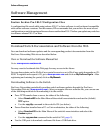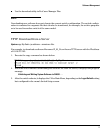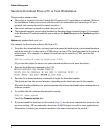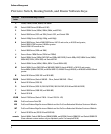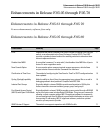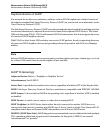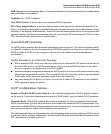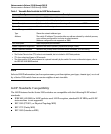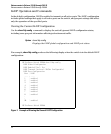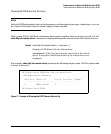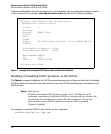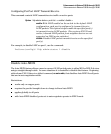
7
Enhancements in Release F.05.05 through F.05.70
Enhancements in Release F.05.05 through F.05.60
Implementation of LLDP
For network device discovery solutions, software version F.05.50 implements a limited version of
the industry standard Link Layer Discovery Protocol (LLDP) on your switch, as an alternative to the
Cisco Discovery Protocol (CDP).
The Link Layer Discovery Protocol (LLDP) provides a standards-based method for enabling switches
to advertise themselves to adjacent devices and to learn about adjacent LLDP devices. The Series
2500 switches using F.05.50 - F.05.59 will transmit LLDP advertisements, but do not support discovery
of connected LLDP neighbor devices.
With F.05.60 or later, Series 2500 switches can receive LLDP packets, thereby supporting discovery
of connected LLDP neighbor devices and providing enhanced operation with ProCurve Manager
utilities.
Note
Selected LLDP information (such as system name, port description, port type, chassis type) received
by a Series 2500 switch from a remote neighbor is not viewable.
LLDP Terminology
Adjacent Device: Refer to “Neighbor or Neighbor Device”.
Advertisement: See LLDPDU.
Active Port: A port linked to another active device (regardless of whether STP is blocking the link).
LLDP: Link Layer Discovery Protocol. ProCurve switches are compatible with IEEE 802.1AB-2005.
LLDP-Aware: A device that has LLDP in its operating code, regardless of whether LLDP is enabled
or disabled.
LLDP Device: A switch, server, router, or other device running LLDP.
LLDP Neighbor: An LLDP device that is either directly connected to another LLDP device or
connected to that device by another, non-LLDP Layer 2 device (such as a hub) Note that an 802.1D-
compliant switch does not forward LLDP data packets even if it is not LLDP-aware.
LLDPDU (LLDP Data Unit): LLDP data packets are transmitted on active links and include multiple
TLVs containing global and per-port switch information. In this guide, LLDPDUs are termed
“advertisements” or “packets”.





